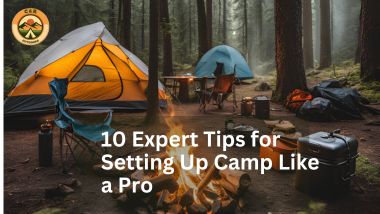You’ve finally reached your campsite after a long day of hiking, and the last thing you want is to struggle with tangled tent poles or an uncomfortable sleeping spot.
Setting up camp can either be a smooth start to your outdoor adventure, or turn into a tangled mess of gear, poles, and frustration if you don’t know basic tips for setting up camp.
But with these 10 expert tips for setting up camp under your belt, you can go from struggling to set up your tent to enjoying the comforts of your campsite in no time. Let’s get started!
10 Tips for Setting Up Camp: All you need to know

1. Choose the Right Campsite
Finding the ideal spot to set up camp is the first and most crucial step. Look for a level area that’s free of hazards like dead trees and rocks.
Be mindful of locations that could flood if it rains. It’s also best to camp near a water source, but make sure you’re far enough away (about 200 feet) to avoid wildlife being drawn to your camp.
Sites with campgrounds often have designated fire pits and lantern hooks, making your setup easier.
2. Tent Setup Made Easy

Setting up your tent properly ensures a good night’s sleep. Find flat ground and lay down a tarp or ground cloth to protect your tent’s base from moisture and sharp objects.
This simple layer of insulation can also provide added warmth. Secure the tent using stakes and guy lines, and remember to set it up with the door facing away from the wind to keep the inside dry.
A cozy sleeping bag and sleeping pad or mattress will give you the comfort you need, especially when the temperatures drop at night.
Also, using safety concious tents especially tents that lock is advisible for your protection.
3. Fire Safety and Cooking Setup
When it’s time to build a campfire, make sure to do it in a designated fire pit if available. Always follow local fire regulations and make sure you have enough firewood to keep it going safely.
Use a camp stove for quick meals, especially in areas where open flames aren’t allowed.
Keep a flashlight or headlamp handy for after-dark cooking, and organize your cooking area with a cooler and utensils stored away from your sleeping quarters to avoid attracting animals.
4. Organize Your Sleeping Area
When camping, and organize your sleeping area will make it more comfortable. After setting up your tent, roll out your sleeping bag and place a sleeping pad or air mattress beneath for added cushion and insulation.
In colder weather, consider layering with an extra blanket or camping gear for warmth. For some added comfort, pack lightweight camping chairs so you can relax by the fire after a long day of hiking.
5. Food Storage and Safety

Food storage is crucial for both convenience and safety. Use bear-proof containers or, if you’re in a pinch, hang your food in a tree far away from your sleeping area.
This will keep unwanted visitors (like bears or raccoons) from scavenging your supplies. It’s also a good idea to pack a cooler to keep perishables fresh during your stay.
6. Be Ready for Any Weather

Camping often means dealing with unpredictable weather conditions. Be prepared with rain gear and always carry a tarp to cover your cooking or lounging area.
A camping lantern, headlamp of flashlight will be invaluable on rainy days when daylight is scarce. Having a charger for essential electronics or a solar lantern is helpful for keeping everything powered up.
7. First-Aid and Emergency Prep
Never go camping without a first-aid kit. Accidents do happen, including minor cuts to more serious injuries. Therefore, being prepared with bandages, antiseptic wipes, and emergency contact numbers is crucial.
For longer trips or remote locations, it’s also worth bringing a GPS device or map for navigation when leaving your campsite.
8. Keep Your Campsite Clean and Organized
Staying organized while camping helps keep your belonging neat and make the experience more enjoyable. Use a tarp to create an outdoor storage area for shoes, backpacks, and other gear.
Keep paper towels, a portable toilet, or toiletry kit nearby for quick cleanups. Trash bags are essential for following the Leave No Trace principle—pack out everything you bring in to protect the environment.
9. Camp Comforts: Fire and Furnishings

Creating a comfortable space is all about adding the right touches. Lightweight camping chairs and a good camp stove can make meal times more enjoyable.
For chilly nights, a propane heater or warm blankets are great additions. Don’t forget a lantern or headlamp to finding your way around your campsite at night easier.
10. Leave No Trace
The most important rule of all: Leave no trace. Respect the environment by cleaning up all waste, including food scraps and firewood remnants.
Follow Leave No Trace principles by minimizing your campfire impact and properly disposing of waste. Make sure to pack out all trash and, if possible, leave the campsite cleaner than you found it.
Conclusion:
Setting up camp doesn’t have to be overwhelming. With these 10 expert tips, you’ll be well on your way to a stress-free, enjoyable camping experience.
For all your weekend adventures or longer trips, proper planning and organization will ensure your camping trip is comfortable, safe, and memorable.
Now that you have everything you need, it’s time to hit the trail, set up camp, and enjoy the great outdoors like a pro!


